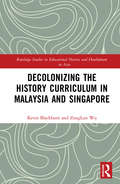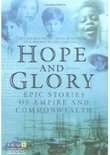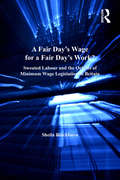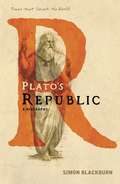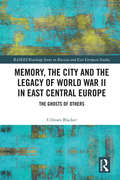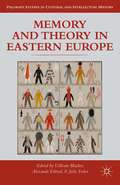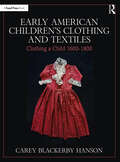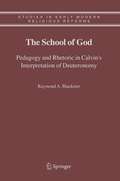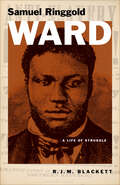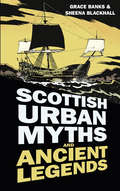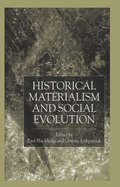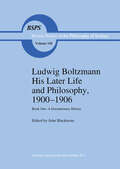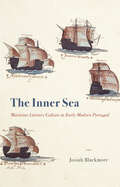- Table View
- List View
Decolonizing the History Curriculum in Malaysia and Singapore (Routledge Studies in Educational History and Development in Asia)
by Kevin Blackburn ZongLun WuDecolonizing the History Curriculum in Malaysia and Singapore is a unique study in the history of education because it examines decolonization in terms of how it changed the subject of history in the school curriculum of two colonized countries – Malaysia and Singapore. Blackburn and Wu’s book analyzes the transition of the subject of history from colonial education to postcolonial education, from the history syllabus upholding the colonial order to the period after independence when the history syllabus became a tool for nation-building. Malaysia and Singapore are excellent case studies of this process because they once shared a common imperial curriculum in the English language schools that was gradually ‘decolonized’ to form the basis of the early history syllabuses of the new nation-states (they were briefly one nation-state in the early to mid-1960s). The colonial English language history syllabus was ‘decolonized’ into a national curriculum that was translated for the Chinese, Malay, and Tamil schools of Malaysia and Singapore. By analyzing the causes and consequences of the dramatic changes made to the teaching of history in the schools of Malaya and Singapore as Britain ended her empire in Southeast Asia, Blackburn and Wu offer fascinating insights into educational reform, the effects of decolonization on curricula, and the history of Malaysian and Singaporean education.
Hope and Glory: Epic Stories of Empire and Commonweath
by M Blackburn S Humphries N Maddocks C TitleyThis work covers tales from local people whose journey through life has taken them from their homeland to Britain as well as those who left the Southwest for a life overseas. Testimonies and reconstructions tell of child migrants, war brides and African immigrants amongst others.
A Fair Day’s Wage for a Fair Day’s Work?: Sweated Labour and the Origins of Minimum Wage Legislation in Britain
by Sheila BlackburnThe nature of sweating and the origins of low pay legislation are of fundamental social, economic and moral importance. Although difficult to define, sweating, according to a select committee established to investigate the issue, was characterised by long hours, poor working conditions and above all by low pay. By the beginning of the twentieth century the government estimated that up to a third of the British workforce could be classed as sweated labour, and for the first time in a century began to think about introducing legislation to address the problem. Whilst historians have written much on unemployment, poverty relief and other such related social and industrial issues, relatively little work has been done on the causes, extent and character of sweated labour. That work which has been done has tended to focus on the tailoring trades in London and Leeds, and fails to give a broad overview of the phenomenon and how it developed and changed over time. In contrast, this volume adopts a broad national and long-run approach, providing a more holistic understanding of the subject. Rejecting the argument that sweating was merely a London or gender related problem, it paints a picture of a widespread and constantly shifting pattern of sweated labour across the country, that was to eventually persuade the government to introduce legislation in the form of the 1909 Trades Board Act. It was this act, intended to combat sweated labour, which was to form the cornerstone of low pay legislation, and the barrier to the introduction of a minimum wage, for the next 90 years.
A Fair Day’s Wage for a Fair Day’s Work?: Sweated Labour and the Origins of Minimum Wage Legislation in Britain
by Sheila BlackburnThe nature of sweating and the origins of low pay legislation are of fundamental social, economic and moral importance. Although difficult to define, sweating, according to a select committee established to investigate the issue, was characterised by long hours, poor working conditions and above all by low pay. By the beginning of the twentieth century the government estimated that up to a third of the British workforce could be classed as sweated labour, and for the first time in a century began to think about introducing legislation to address the problem. Whilst historians have written much on unemployment, poverty relief and other such related social and industrial issues, relatively little work has been done on the causes, extent and character of sweated labour. That work which has been done has tended to focus on the tailoring trades in London and Leeds, and fails to give a broad overview of the phenomenon and how it developed and changed over time. In contrast, this volume adopts a broad national and long-run approach, providing a more holistic understanding of the subject. Rejecting the argument that sweating was merely a London or gender related problem, it paints a picture of a widespread and constantly shifting pattern of sweated labour across the country, that was to eventually persuade the government to introduce legislation in the form of the 1909 Trades Board Act. It was this act, intended to combat sweated labour, which was to form the cornerstone of low pay legislation, and the barrier to the introduction of a minimum wage, for the next 90 years.
Plato's Republic: A Biography (A Book that Shook the World) (BOOKS THAT SHOOK THE WORLD)
by Simon BlackburnPlato is perhaps the most significant philosopher who has ever lived and The Republic, composed in Athens in about 375BC, is widely regarded as his most famous dialogue. Its discussion of the perfect city - and the perfect mind - laid the foundations for Western culture and, for over two thousand years, has been the cornerstone of Western philosophy. In this book, Simon Blackburn explains the judicial, moral and political ideas in the Republic and examines its influence on the modern world. He shows why, from St Augustine to twentieth-century philosophers such as Whitehead and Bergson, Western thought is still conditioned by this most important of books.
Memory, the City and the Legacy of World War II in East Central Europe: The Ghosts of Others (BASEES/Routledge Series on Russian and East European Studies)
by Uilleam BlackerAfter the Second World War, millions of people across Eastern Europe, displaced as a result of wartime destruction, deportations and redrawing of state boundaries, found themselves living in cities that were filled with the traces of the foreign cultures of the former inhabitants. In the immediate post-war period these traces were not acknowledged, the new inhabitants going along with official policies of oblivion, the national narratives of new post-war regimes, and the memorializing of the victors. In time, however, and increasingly over recent decades, the former "other pasts" have been embraced and taken on board as part of local cultural memory. This book explores this interesting and increasingly important phenomenon. It examines official ideologies, popular memory, literature, film, memorialization and tourism to show how other pasts are being incorporated into local cultural memory. It relates these developments to cultural theory and argues that the relationship between urban space, cultural memory and identity in Eastern Europe is increasingly becoming a question not only of cultural politics, but also of consumption and choice, alongside a tendency towards the cosmopolitanization of memory.
Memory, the City and the Legacy of World War II in East Central Europe: The Ghosts of Others (BASEES/Routledge Series on Russian and East European Studies)
by Uilleam BlackerAfter the Second World War, millions of people across Eastern Europe, displaced as a result of wartime destruction, deportations and redrawing of state boundaries, found themselves living in cities that were filled with the traces of the foreign cultures of the former inhabitants. In the immediate post-war period these traces were not acknowledged, the new inhabitants going along with official policies of oblivion, the national narratives of new post-war regimes, and the memorializing of the victors. In time, however, and increasingly over recent decades, the former "other pasts" have been embraced and taken on board as part of local cultural memory. This book explores this interesting and increasingly important phenomenon. It examines official ideologies, popular memory, literature, film, memorialization and tourism to show how other pasts are being incorporated into local cultural memory. It relates these developments to cultural theory and argues that the relationship between urban space, cultural memory and identity in Eastern Europe is increasingly becoming a question not only of cultural politics, but also of consumption and choice, alongside a tendency towards the cosmopolitanization of memory.
Memory and Theory in Eastern Europe (Palgrave Studies in Cultural and Intellectual History)
by Uilleam Blacker Alexander EtkindIt is the aim of this volume to investigate how academic practices of Memory Studies are being applied, adapted, and transformed in the countries of East-Central Europe and the former Soviet Union. It affords a new, startlingly different perspective for scholars of both Eastern European history and Memory Studies.
Early American Children’s Clothing and Textiles: Clothing a Child 1600-1800
by Carey Blackerby HansonEarly American Children’s Clothing and Textiles: Clothing a Child 1600–1800 explores the life experiences of Indigenous, Anglo-European, African, and mixed-race children in colonial America, their connections to textile production, the process of textile production, the textiles created, and the clothing they wore. The book examines the communities and social structure of early America, the progression of the colonial textile industry, and the politics surrounding textile production beginning in the 1600's, with particular focus on the tasks children were given in the development of the American textile industry. The book discusses the concept of childhood in society during this time, together with documented stories of individual children. The discussion of early American childhood and textile production is followed by extant clothing samples for both boys and girls, ranging from Upper-class children's wear to children's wear of those with more humble means. With over 180 illustrations, the book includes images of textile production tools, inventions, and practices, extant textile samples, period portraits of children, and handmade extant clothing items worn by children during this time period. Early American Children’s Clothing and Textiles: Clothing a Child 1600–1800 will be of interest to working costume designers and technicians looking for primary historical and visual information for Early American productions, costume design historians, early American historians, students of costume design, and historical re-enactment costume designers, technicians, and hobbyists.
Early American Children’s Clothing and Textiles: Clothing a Child 1600-1800
by Carey Blackerby HansonEarly American Children’s Clothing and Textiles: Clothing a Child 1600–1800 explores the life experiences of Indigenous, Anglo-European, African, and mixed-race children in colonial America, their connections to textile production, the process of textile production, the textiles created, and the clothing they wore. The book examines the communities and social structure of early America, the progression of the colonial textile industry, and the politics surrounding textile production beginning in the 1600's, with particular focus on the tasks children were given in the development of the American textile industry. The book discusses the concept of childhood in society during this time, together with documented stories of individual children. The discussion of early American childhood and textile production is followed by extant clothing samples for both boys and girls, ranging from Upper-class children's wear to children's wear of those with more humble means. With over 180 illustrations, the book includes images of textile production tools, inventions, and practices, extant textile samples, period portraits of children, and handmade extant clothing items worn by children during this time period. Early American Children’s Clothing and Textiles: Clothing a Child 1600–1800 will be of interest to working costume designers and technicians looking for primary historical and visual information for Early American productions, costume design historians, early American historians, students of costume design, and historical re-enactment costume designers, technicians, and hobbyists.
The School of God: Pedagogy and Rhetoric in Calvin's Interpretation of Deuteronomy (Studies in Early Modern Religious Tradition, Culture and Society #3)
by Raymond A. BlacketerCalvin’s Old Testament Exegesis in Context Calvin in Context Jean Calvin, the reformer and pastor of Geneva, is renowned as one of the most important figures in what came to be known as the Reformed and Presbyterian branch of the Protestant Reformation. Perhaps less well known is the fact that he devoted the bulk of his creative efforts to prea- ing, lecturing, and commenting on the Bible. Calvin envisioned a program of reform in Geneva in which the Bible, properly interpreted, would shape the minds and morals of the Genevan populace. The people of Geneva, whom Calvin viewed as a precise spiritual reincarnation of the “sti- necked, intractable Hebrews” of the Old Testament, were in need of some serious remedial education, and it was his duty as their chief minister to provide the requisite training in doctrine and godliness. Despite Calvin’s emphasis on preaching and producing biblical c- mentaries, however, scholars have often portrayed him as “a man of one 1 book”—that one book being the Institutes of the Christian Religion. In so - ing, they have produced a one-dimensional and consequently incomplete view of Calvin’s theological work. Scholars have tended to study Calvin’s theology exclusively from the perspective of his Institutes, without taking into account his work of biblical interpretation and preaching, or the re- tionship of those efforts to the Institutes.
Samuel Ringgold Ward: A Life of Struggle (Black Lives)
by R. J. BlackettThe rediscovery of a pivotal figure in Black history and his importance and influence in the struggle against slavery and discrimination Born on the Eastern Shore of Maryland, Samuel Ringgold Ward (1817–c. 1869) escaped enslavement and would become a leading figure in the struggle for Black freedom, citizenship, and equality. He was extolled by his contemporary Frederick Douglass for his “depth of thought, fluency of speech, readiness of wit, logical exactness.” Until now, his story has been largely untold. Ward, a newspaper editor, Congregational minister, and advocate for the temperance movement, was considered one of the leading orators of his time. After the passage of the Fugitive Slave Act of 1850 he fled to Canada, where he lectured widely to improve conditions for formerly enslaved people who had settled there. Ward then went to Britain as an agent of the Canadian Antislavery Society and published his influential book Autobiography of a Fugitive Negro. He never returned to the United States, and he died in obscurity in Jamaica. Despite Ward’s prominent role in the abolitionist movement, his story has been lost because of the decades he spent in exile. In this book, R. J. M. Blackett brings light to Ward’s life and his important role in the struggle against slavery and discrimination, and to the personal price he paid for confronting oppression.
Scottish Urban Myths and Ancient Legends (Urban Legends Ser.)
by Sheena Blackhall Grace BanksMonsters, lunatics, vampires, werewolves and evil dolls, stones entombing bodies, faces appearing in walls, curses and meetings with the Devil – all this and more are contained within this book of myths and ancient legends. Well-known storytellers Grace Banks and Sheena Blackhall recount a range of intriguing tales from the top to the bottom of Scotland, from ancient times to the present day. Folklore embeds itself in a local community, often to the extent that some people believe all manner of mysteries and take them as fact. Whether they’re stories passed around the school playground, through the Internet, or round a flickering campfire, such legends are everywhere. Scottish Urban Myths and Ancient Legends is a quirky and downright spooky ride into the heart of Celtic folklore.
Violence over the Land: Indians And Empires In The Early American West
by Ned BlackhawkRanging across Utah, Nevada, New Mexico, Colorado, and eastern California, this title places Native peoples squarely at the center of a story that chronicles two centuries of Indian and imperial history.
Indigenous Visions: Rediscovering the World of Franz Boas (The Henry Roe Cloud Series on American Indians and Modernity)
by Ned Blackhawk Isaiah Lorado WilnerA compelling study that charts the influence of Indigenous thinkers on Franz Boas, the founder of modern anthropology In 1911, the publication of Franz Boas’s The Mind of Primitive Man challenged widely held claims about race and intelligence that justified violence and inequality. Now, a group of leading scholars examines how this groundbreaking work hinged on relationships with a global circle of Indigenous thinkers who used Boasian anthropology as a medium for their ideas. Contributors also examine how Boasian thought intersected with the work of major modernist figures, demonstrating how ideas of diversity and identity sprang from colonization and empire.
The Rediscovery of America: Native Peoples and the Unmaking of U.S. History (The Henry Roe Cloud Series on American Indians and Modernity)
by Ned Blackhawk YA sweeping and overdue retelling of U.S. history that recognizes that Native Americans are essential to understanding the evolution of modern America "In accounts of American history, Indigenous peoples are often treated as largely incidental—either obstacles to be overcome or part of a narrative separate from the arc of nation-building. Blackhawk . . . [shows] that Native communities have, instead, been inseparable from the American story all along."—Washington Post Book World, "Books to Read in 2023" The most enduring feature of U.S. history is the presence of Native Americans, yet most histories focus on Europeans and their descendants. This long practice of ignoring Indigenous history is changing, however, with a new generation of scholars insists that any full American history address the struggle, survival, and resurgence of American Indian nations. Indigenous history is essential to understanding the evolution of modern America. Ned Blackhawk interweaves five centuries of Native and non‑Native histories, from Spanish colonial exploration to the rise of Native American self-determination in the late twentieth century. In this transformative synthesis he shows that • European colonization in the 1600s was never a predetermined success; • Native nations helped shape England’s crisis of empire; • the first shots of the American Revolution were prompted by Indian affairs in the interior; • California Indians targeted by federally funded militias were among the first casualties of the Civil War; • the Union victory forever recalibrated Native communities across the West; • twentieth-century reservation activists refashioned American law and policy. Blackhawk’s retelling of U.S. history acknowledges the enduring power, agency, and survival of Indigenous peoples, yielding a truer account of the United States and revealing anew the varied meanings of America.
Historical Materialism and Social Evolution
by P. Blackledge G. KirkpatrickHistorical Materialism and Social Evolution brings together a collection of essays which investigate the relationship between Marxist thought and Darwin's theory of evolution by natural selection. Each of the contributors emphasize the idea that the distinctive character of progressive social thought is derived from creative ideas drawn from the study of natural evolutionary processes.
Reflections on the Marxist theory of history
by Paul BlackledgeA decade after Francis Fukuyama announced the ‘End of History’, anti-capitalist demonstrators at Seattle and elsewhere have helped reinvigorate the Left with the reply ‘another world is possible’. More than anyone else it was Marx who showed that slogans such as this were no utopian fantasies, and that capitalism was just as much a historical mode of production, no more natural and certainly no less contradictory, than were the feudal and slave modes which proceeded it. Paul Blackledge opens this study with a defence of the Marxist approach to the study of history against what he argues as being the naive empiricism of traditional historians and the relativism of the postmodernists. He moves on to outline Marx and Engels analyses of concrete historical processes and their critiques of the alternative historiographic methodologies of their contemporaries. He then discusses neglected historical works produced by Marxists in the half-century or so after Marx and Engels’ deaths. Two central chapters survey recent Marxist debates on, first, the nature of modes of productions, including slave, feudal and tributary systems, and the revolutionary transitions between them; and, second, the methodological debate over the issue of structure and agency in the movement of history. Finally, he shows the political relevance of these debates through a concluding survey of competing Marxist attempts to periodise the present, postmodern, conjuncture. This book should be read by historians, students of cultural, social and political theory and anti-capitalist activists.
The Emergence of the Fourth Dimension: Higher Spatial Thinking in the Fin de Siècle
by Mark BlacklockThe Emergence of the Fourth Dimension describes the development and proliferation of the idea of higher dimensional space in the late nineteenth- and early twentieth-centuries. An idea from mathematics that was appropriated by occultist thought, it emerged in the fin de siècle as a staple of genre fiction and influenced a number of important Modernist writers and artists. Providing a context for thinking of space in dimensional terms, the volume describes an active interplay between self-fashioning disciplines and a key moment in the popularisation of science. It offers new research into spiritualism and the Theosophical Society and studies a series of curious hybrid texts. Examining works by Joseph Conrad, Ford Madox Ford, H.G. Wells, Henry James, H. P. Lovecraft, and others, the volume explores how new theories of the possibilities of time and space influenced fiction writers of the period, and how literature shaped, and was in turn shaped by, the reconfiguration of imaginative space occasioned by the n-dimensional turn. A timely study of the interplay between philosophy, literature, culture, and mathematics, it offers a rich resource for readers interested in nineteenth century literature, Modernist studies, science fiction, and gothic scholarship.
The Emergence of the Fourth Dimension: Higher Spatial Thinking in the Fin de Siècle
by Mark BlacklockThe Emergence of the Fourth Dimension describes the development and proliferation of the idea of higher dimensional space in the late nineteenth- and early twentieth-centuries. An idea from mathematics that was appropriated by occultist thought, it emerged in the fin de siècle as a staple of genre fiction and influenced a number of important Modernist writers and artists. Providing a context for thinking of space in dimensional terms, the volume describes an active interplay between self-fashioning disciplines and a key moment in the popularisation of science. It offers new research into spiritualism and the Theosophical Society and studies a series of curious hybrid texts. Examining works by Joseph Conrad, Ford Madox Ford, H.G. Wells, Henry James, H. P. Lovecraft, and others, the volume explores how new theories of the possibilities of time and space influenced fiction writers of the period, and how literature shaped, and was in turn shaped by, the reconfiguration of imaginative space occasioned by the n-dimensional turn. A timely study of the interplay between philosophy, literature, culture, and mathematics, it offers a rich resource for readers interested in nineteenth century literature, Modernist studies, science fiction, and gothic scholarship.
Luxor And Its Temples
by A.M. BlackmanFirst published in 2005. Routledge is an imprint of Taylor & Francis, an informa company.
Luxor And Its Temples
by A.M. BlackmanFirst published in 2005. Routledge is an imprint of Taylor & Francis, an informa company.
Ludwig Boltzmann His Later Life and Philosophy, 1900–1906: Book One: A Documentary History (Boston Studies in the Philosophy and History of Science #168)
by J. T. Blackmore2 But already he had done important work on thermal equilibrium which helped generalize Maxwell's distribution law. Indeed, there is part of a letter by James Clerk Maxwell to Loschmidt from this period which runs: "I am very pleased over the outstanding work of your student; in England experi mental physics is much neglected. Sir William Thomson has done the most in this connection, but you [in Austria] are ahead of us with your good example. "2 But while praise was fine, Boltzmann lusted after further travel. He wanted to know what other physicists were doing first hand. In 1870 he attended lectures by Bunsen and Konigsberger in Heid elberg, and in the same year went to Berlin only to scurry back to Vienna with the outbreak of the Franco-Prussian War, but Boltzmann was back in Berlin the next year attending lectures, visiting laboratories, and working on dielectricity more or less under the direction of Kirchhhoff and Helmholtz.
Ernst Mach's Vienna 1895-1930: Or Phenomenalism as Philosophy of Science (Boston Studies in the Philosophy and History of Science #218)
by J. T. Blackmore R. Itagaki S. TanakaSection Guide 1. Prolegomena 2. Biographical Sketch 3. Epistemology 4. Textbook Ontology 1. PROLEGOMENA While both philosophers and historians almost always love truth and the search for truth, and both often carry out extensive research, there can be noticeable differences when historians write about the history of philosophy and when philosophers write about it. Philosophers often look at the past with categories and interests taken from the present or at the least from the recent past, but many historians, especially those who love research for its own sake, will try to look at the past from a perspective either from that period or from even earlier. Both camps look for roots, but view them with different lenses and presupposi tions. This prolegomena has been added to prepare some philosophers for what will hopefully only be the mildest of shocks, for seeing the history of philosophy in a way which does not treat what is recent or latest as best, but which loves the context of ideas for its own sake, a context which can be very foreign to contemporary likes and dislikes. To be sure, we historians can deceive ourselves as easily as philosophers, but we tend to do so about different things.
The Inner Sea: Maritime Literary Culture in Early Modern Portugal
by Josiah BlackmoreAn expansive consideration of how nautical themes influenced literature in early modern Portugal. In this book, Josiah Blackmore considers how the sea and seafaring shaped literary creativity in early modern Portugal during the most active, consequential decades of European overseas expansion. Blackmore understands “literary” in a broad sense, including a diverse archive spanning genres and disciplines—epic and lyric poetry, historical chronicles, nautical documents, ship logs, shipwreck narratives, geographic descriptions, and reference to texts of other seafaring powers and literatures of the period—centering on the great Luís de Camões, arguably the sea poet par excellence of early modern Europe. Blackmore shows that the sea and nautical travel for Camões and his contemporaries were not merely historical realities; they were also principles of cultural creativity that connected to larger debates in the widening field of the maritime humanities. For Blackmore, the sea, ships, and nautical travel unfold into a variety of symbolic dimensions, and the oceans across the globe that were traversed in the fifteenth and sixteenth centuries correspond to vast reaches within the literary self. The sea and seafaring were not merely themes in textual culture but were also principles that created individual and collective subjects according to oceanic modes of perception. Blackmore concludes with a discussion of depth and sinking in shipwreck narratives as metaphoric and discursive dimensions of the maritime subject, foreshadowing empire’s decline.
